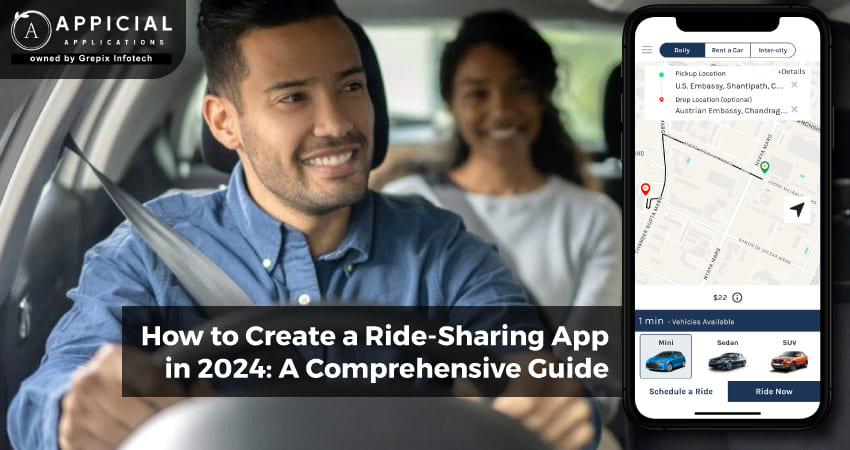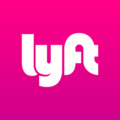
How to Create a Ride-Sharing App in 2024: A Comprehensive Guide
The expansion of the global ridesharing market has been extraordinarily rapid, with the United States seeing significant revenues from industry leaders such as Uber, Lyft, and DiDi. BlaBlaCar, Europe's most popular ridesharing platform, has expanded its reach to 400 cities and boasts 1.5 million users, signaling the vast potential and acceptance of ridesharing services across different regions.
This growth trajectory is far from reaching its peak. Projections indicate that the ridesharing market is on track for an impressive growth rate of over 50% between 2020 and 2021, with its valuation expected to soar to approximately $117 billion by 2021. Such expansion underscores the increasing consumer preference for ridesharing over traditional transportation methods, with research suggesting that rideshares account for about 70% of all car passenger trips.
Given this backdrop, the interest in launching new ridesharing apps is surging. For entrepreneurs looking to enter this lucrative market, understanding the critical steps to developing a competitive rideshare app is essential. This guide aims to provide an overview of the necessary features, the team composition required, and the investment needed to bring a rideshare app to life.
The blog outlines the booming ride-sharing market, with giants like Uber and Lyft leading the way. BlaBlaCar's success in Europe and the projection of the market's exponential growth further underscore the potential. It delves into the essential steps for developing a competitive ride-sharing app: market research, defining the target audience, legal compliance, app features and design, technology stack, testing, launch strategy, post-launch management, monetization, and analytics. Additionally, it highlights the key features of passenger, driver, and admin apps, emphasizing the importance of a user-friendly interface and comprehensive functionality. Lastly, it touches on the benefits of ride-sharing app development for businesses, communities, and users, and concludes by introducing Appicial Applications as a reliable partner in app development, offering expertise and guidance to navigate the competitive ride-sharing landscape.
How to create a rideshare app
Creating a rideshare app in today's rapidly expanding market is a promising yet challenging venture. With the industry set to grow significantly, understanding the essential steps to develop a competitive and successful rideshare app is crucial. Here’s a streamlined guide to get you started:
Market Research and Conceptualization
- Understand the Market: Analyze the current landscape, key players (like Uber, Lyft, DiDi, and BlaBlaCar), and identify gaps or niches you can target.
- Define Your Unique Value Proposition (UVP): Determine what will make your app stand out. This could be anything from lower prices, specialized services, or better features.
Define Your Target Audience
- User Profiles: Identify who your users are (drivers and passengers) and understand their needs and preferences.
- Service Area: Decide on the geographic location where you will launch your app first.
Legal Framework and Compliance
- Regulations: Research the legal requirements and regulations for operating a rideshare service in your chosen area.
- Insurance and Licenses: Secure necessary insurance for drivers and passengers, and obtain any required business licenses.
App Features and Design
- Essential Features: Include must-have features for both driver and rider apps, such as GPS tracking, payment integration, ratings and reviews, and safety features.
- Design: Focus on creating a user-friendly UI/UX design. The app should be intuitive for users to navigate.
Technology Stack and Development
- Choose a Technology Stack: Select the right technologies for both front-end and back-end development. Consider using cloud services for scalability.
- Development Team: Decide whether to develop in-house or outsource. You’ll need a team of developers, UI/UX designers, and QA testers.
Testing and Quality Assurance
- Beta Testing: Conduct thorough testing with a closed group of users to gather feedback and make necessary adjustments.
- Quality Assurance: Ensure the app is reliable, secure, and user-friendly.
Launch Strategy
- Soft Launch: Consider a soft launch in a limited area to refine your service based on real-world use.
- Marketing and Promotion: Develop a marketing plan to generate buzz around your app. Use social media, content marketing, and PR to reach your target audience.
Post-Launch Management and Scaling
- Customer Support: Set up a responsive customer support system for users and drivers.
- Iterate Based on Feedback: Continuously update the app based on user feedback and market demands.
- Scale Gradually: Plan for gradual expansion to new areas and possibly introduce new features or services.
Monetization Strategy
- Decide on Your Revenue Model: Whether it’s taking a percentage of fares, subscription models, or advertising, choose a monetization strategy that aligns with your business goals.
Analytics and Improvement
- Implement Analytics: Use analytics tools to monitor app performance, user engagement, and other key metrics.
- Continuous Improvement: Use the data collected to improve your service continually and stay competitive.
Essential features of Ridesharing App
Developing an app like Uber is a complex and time-consuming process, requiring careful planning, execution, and ongoing management. Success in the ride-sharing industry requires not just a functional and user-friendly app, but also a strong business model, effective marketing, and a commitment to continuous improvement and customer satisfaction. Here are features of Uber Clone App as per given below:
Passenger app
The Passenger App is a pivotal component of ride-sharing services, designed to provide users with a seamless and intuitive interface for booking rides, tracking drivers, managing payments, and reviewing their journey experiences. It's the direct point of interaction between the service and the passengers, making its usability, reliability, and efficiency crucial for ensuring customer satisfaction and loyalty. Here are some important features as per given below:
- Login / Registration: Rider can login and register his account through social media accounts, email and password & mobile number.
- Create Profile: Rider can create his profile by adding details including name, email Id, contact number, password, and country.
- Select / Enter Location Details: Riders can choose the pickup and drop-off location before they book a ride by entering an address or selecting on map (tap here).
- Vehicle Categories: Riders can select the vehicle from available options like hatchback, sedan, mini, or suv.
- Ride Now or Later: Riders can book a taxi for a ride now. Or schedule rides by later date and time by using the "ride later" option.
- Detailed Fare breakup: Rider can view the fare estimates of the ride (based on the selected vehicle category and locations).
- Promo Code: In this taxi feature riders can use promo code to get an extra discount on the total trip amount, and promo code is managed through the admin panel.
- Reviews and Rating: In this feature riders can give reviews and rating at the end of the trip as per their experience of the taxi services and drivers.
- Get Driver’s Information: After a ride is accepted by the driver, a rider can view drivers details like –name, image, contact number, and be able to call the driver.
- SOS Button: In case of emergency, a rider will click on an SOS button, and their location details with a message will be sent to his saved contact for emergency.
- Cancel Trip: In this feature riders can cancel the trip by providing a reason, and they also may have to pay the cancellation charges.
- Multiple Payment Methods: In this taxi feature riders can choose any payment mode like credit card, cash or wallet.
- Forgot Password: If rider forgets the password, they can recover it and set the new password.
- Fare Summary Details: In this taxi app feature rider can view all the details, including the total distance, time, amount to be paid, and referral code.
- Wait Time Charges: If the driver has to wait for the rider, then additional charges will be applied to waiting time, which rider has to pay. Real-Time Tracking of Driver: Rider can get the real-time status of driver like, on the way, estimated time of arrival etc.
- Live Tracking: In this feature riders will get real-time updates for ride accepted, driver arrival, begin ride, end ride or cancel.
- Notifications: In this feature riders will receive all the notifications about ride accepted, driver status, begin ride, end ride, payment confirmation etc.
- Vehicle Details: After the ride is accepted, the rider can view all the details related to the vehicle. Like, Car type, car number with the trip number.
- Ride History: In this feature riders can view all the rides completed, canceled including details of pickup and drop location, fare amount and time.
- Edit/Update Profile: Rider can update their profile like name, address, password, profile image etc.
Driver app
The Driver App is a critical component of ride-sharing platforms, designed to facilitate drivers with the tools they need for efficient operation, communication, and navigation. This app serves as the backbone for drivers, enabling them to accept ride requests, navigate to the passenger's location, manage their earnings, and communicate with passengers. Here's a breakdown of key features typically found in a driver app:
- Login/Registration: The driver can register through social media accounts and need to get verified by the admin before he can get ride requests on the app.
- Document Uploading: Driver is required to upload their documents like Id proof, License and registration certificate at the time of register, all details will be sent to admin for approval.
- Document Verification: Admin will verify the documents uploaded by driver and set status as verified through admin panel to ensure security and authenticity. Only after approved by admin, driver can receive ride requests and able to accept rides.
- Edit/Update Profile: Driver can manage their profile details like name, address, contact details, profile photos, and documents.
- Ride Requests: Once approved by admin, driver can start getting ride requests from the nearby locations.
- Accept/Reject Ride: This taxi app feature allow driver to accept or reject the ride request received from riders within 30 seconds.
- Cancel Ride: Driver can also cancel the ride if he is not picked up the rider with cancellation reasons like wrong address on the map or any valid reason.
- Geo-fenced Service Area: By marking the Geographical boundaries of some areas, you can avoid crime prone or unsafe areas by marking them with geo-fencing and avoiding pick up and drop in these areas.
- Google Navigation: It enables the driver to head upon Google maps app for directions and traffic assistance. Drivers can also view real-time car transitions on the map, and it helps them find the route to reach the rider easily.
- Driver’s Availability: Driver can switch their availability anytime to Online /Offline. Driver can’t receive a ride request while he is offline.
- Earnings: Drivers can see the earning reports on a daily, monthly and weekly basis, including all necessary details and payment methods.
- Ride History: Driver can view all the rides completed, canceled including details of pickup and drop location, fare amount and time.
- Call / Chat: Driver can call /text to rider for any queries related to the ride.
- Deactivate Profile: This taxi app feature allows drivers to deactivate their profile through the app.
- Driver’s Multiple Shifts: This taxi app feature allows drivers to work in multiple shifts (Day & Night) to make more money.This taxi app feature allows drivers to work in multiple shifts (Day & Night) to make more money.
Admin Panel
The Admin Panel serves as the control center for ride-sharing platforms, providing administrators with comprehensive tools to manage both the rider and driver experiences, monitor operations, and make data-driven decisions. This web-based dashboard is crucial for maintaining the smooth functioning of the service, overseeing user activity, resolving disputes, and enhancing overall service quality. Key features of an Admin Panel include:
- Drivers Manager: The admin panel is empowered to comprehensively manage driver access on the platform. This includes the ability to verify or block drivers, request additional documents, monitor their performance, review their wallet status, examine documents, oversee referrals, and much more. We've designed the admin role to act as a superpower, granting them full control over operational aspects in real-time.
- Users Manager: Similarly, the driver manager is granted full authority over the rider's access to the platform. This role encompasses the ability to manage or observe their booked, canceled, and completed rides, as well as to resolve any issues or grievances directly from the panel.
- Transactions Manager: The admin has the capability to monitor all transactions occurring on the platform. Additionally, they can delve into the specifics of each transaction, including taxes, commission, payment methods, wallet transfers, and more, ensuring a comprehensive understanding of the platform's financial flows.
- Wallet Manager: The foundational advantage of our platform lies in its integrated wallet system, setting us apart from competitors. Once comprehended, it becomes evident that such a system is essential for business operations. This feature not only aids in retaining both riders and drivers by enhancing their engagement with the platform, but it also enables the company to maintain a higher level of funds, fostering a more robust economic ecosystem within the platform.
- Trips/Rides Manager: The admin has the capability to monitor rides in real-time, including those that are ongoing, completed, canceled, missed, or rejected by drivers. Furthermore, the admin possesses the authority to dispatch rides directly from the admin panel and manually assign drivers to booked rides, offering a high level of operational control and flexibility in managing ride allocations.
- Reports: The admin is provided with access to a wide range of reports, enabling them to effectively plan and strategize various activities aimed at supporting and expanding the business. These reports offer valuable insights into operations, financial performance, user engagement, and more, serving as a critical tool for informed decision-making and strategic development.
Implementing Core Features
A successful taxi booking app should include a range of core features to meet the needs of both passengers and drivers. These features may include:
- Login and Registration: Allow users to create accounts and login securely using email, phone number, or social media accounts.
- Booking interface: Enable users to enter their pickup and drop-off locations, choose vehicle types, and schedule rides in advance.
- Real-time tracking: Provide users with real-time updates on their driver's location, estimated.
- Multiple payments mode : Offer secure payment options, such as credit/debit cards, mobile wallets, or cash, for seamless transactions.
- Rating and feedback : Allow users to rate their rides and provide feedback on their experience to maintain service quality.
- Driver management dashboard: Provide drivers with a dedicated dashboard to manage ride requests, navigation, earnings, and customer feedback.
Top Ride Sharing Apps In The Market
Ride-sharing app development has revolutionized urban mobility, offering convenient, cost-effective, and eco-friendly transportation options. The market is dominated by several top solutions, each with unique features catering to various user needs. Here's an overview of the leading ride-sharing apps that have significantly impacted the market:

Uber
Launched by Uber, uberPOOL stands out as an efficient ride-sharing option. It offers competitive pricing compared to similar services, and thanks to its extensive network of drivers, users can easily find rides at standard fares on most days. UberPOOL offers a cost-effective alternative to traditional taxis, making it more affordable for users. For those traveling in groups, it provides a convenient way to divide the fare among passengers. While Uber is a dominant force in the carpooling industry, it's worth exploring other competitive platforms as well.

Lyft
Lyft, recognized as the second-largest ride-sharing application, operates across more than 600 cities in the U.S., including major urban centers like New York, Los Angeles, and San Francisco. In its push for international expansion, Lyft now also serves 12 cities in Canada. The platform boasts a varied fleet that includes standard mid-sized vehicles and the more spacious Lyft Plus options. Additionally, Lyft has embraced scooter services, further diversifying its transport offerings.Moreover, Lyft introduces a car-sharing feature, Lyft Line, which facilitates fare splitting among users, enhancing affordability and convenience for its customers.

BlaBlaCar
BlaBlaCar stands as the foremost global online service for ride-sharing, boasting an impressive user base exceeding 35 million. Launched in 2006 in Paris, this international carpooling platform has extended its reach to 22 countries, with this number expanding annually. As of January 2016, BlaBlaCar was valued at $1.6 billion. The platform operates by facilitating connections between drivers (who are private car owners) and passengers for shared rides. Drivers post available seats in their vehicles, while passengers looking to travel to the same destination can book these spots. Passengers specify their starting point and destination, and the platform then matches them with suitable driver offers. Following the journey, users have the opportunity to leave public feedback about their experience with one another, enhancing the community's trust and safety.

Gett
This Israeli-based ride-sharing app, initially known as GetTaxi, offers considerable benefits with its services spanning over 100 cities worldwide, notably in the United Kingdom and Israel. Recently, Gett has ceased its operations in the United States, a strategic move motivated by regulatory compliance issues and a shift in focus towards the corporate transportation sector. Despite this, Gett has maintained its presence in the U.S. market through a strategic partnership with Lyft. This collaboration allows Gett users in the USA to book rides with Lyft directly through the Gett app, offering a wide range of transportation options from standard taxis to luxury limousines.One of the key advantages of Gett is its pricing strategy. The company has made a significant move by abolishing surge pricing, ensuring that fares do not increase during periods of high demand, which stands as a strong appeal for users seeking consistent and predictable pricing.

Via
Via, a startup aiming to redefine urban mobility, has developed an innovative ride-sharing platform focused on facilitating shared rides among passengers heading in the same direction. Through its user-friendly mobile application, Via connects individuals with similar travel destinations, allowing them to share a single vehicle—typically a large SUV or van—for their journey. The core of Via's service is its sophisticated algorithm that matches multiple passengers in real-time who are looking to travel to the same endpoint. This system efficiently consolidates rides, optimizing both the route and vehicle capacity. Passengers are then directed to gather at designated virtual bus stops, strategically chosen based on current traffic conditions and demand, ensuring a seamless pick-up process without significantly detouring from the planned route.

Curb
Curb is a ride-sharing platform that has mastered the art of on-demand transportation, operating on a model similar to that of Uber and Lyft by facilitating requests to connect drivers with passengers for shared destinations. What sets Curb apart is its ability to allow users to pre-schedule rides in certain cities for a nominal fee of $2. This feature is particularly useful for those who anticipate the need for a car, enabling them to arrange for a Curb driver to be waiting at a predetermined time and location. Moreover, Curb guarantees a fixed price for these pre-scheduled rides, ensuring that passengers are not subject to unexpected charges. Expanding its innovative offerings, Curb introduces the Pair and Pay feature in key cities such as New York, Boston, Philadelphia, Miami, and Las Vegas. This feature simplifies the payment process by enabling passengers to pay through the app after entering a specific code for the chosen cab. This blend of convenience, predictability, and technological integration positions Curb as a unique and valuable player in the competitive ride-sharing market.
Benefits Of Ride Sharing App Development
For Businesses
- New Revenue Streams: Ride-sharing apps open up new avenues for generating income through various channels, including ride fares, subscription models, advertising, and partnership deals.
- Market Expansion: These apps allow businesses to tap into the growing demand for efficient, cost-effective transportation solutions, expanding their market reach.
- Data Insights: Ride-sharing platforms generate valuable data on user behavior, preferences, and travel patterns, which can be leveraged to optimize services, marketing strategies, and operational efficiency.
- Brand Visibility: A well-designed ride-sharing app can significantly enhance brand recognition and loyalty among users, setting the company apart in
For Communities
- Reduced Traffic Congestion: By encouraging carpooling, ride-sharing apps can help decrease the number of vehicles on the road, leading to less traffic congestion and shorter travel times.
- Environmental Benefits: Fewer cars on the road mean reduced carbon emissions and pollution, contributing to a healthier environment.
- Economic Opportunities: Ride-sharing apps create new job opportunities for drivers and can stimulate local economies by increasing mobility and access to services.
For Users
- Convenience: Users can book rides with just a few taps on their smartphones, making transportation more accessible and convenient than ever before.
- Cost Savings: Sharing rides can be more economical than owning and maintaining a personal vehicle, especially with the ability to split fares among multiple passengers.
- Safety Features: Modern ride-sharing apps include several safety features, such as driver verification, real-time GPS tracking, and emergency contact integration, enhancing the safety of passengers.
- Flexibility: With options ranging from immediate pickups to advanced bookings and various vehicle choices, users have the flexibility to plan their rides according to their specific needs and preferences.
Conclusion
Appicial Applications, a forward-thinking IT consulting and on-demand app development company, excels in leveraging the latest technologies to craft highly functional apps across various industries. Our commitment to exceeding client expectations is evident in our approach to rapid software development.
With the detailed insights provided above, you have the flexibility to select the features that best align with your vision for a ridesharing app and the development path that suits your needs. Whether you're aiming to carve a niche in the lucrative and growing ridesharing market with a standout prototype or a minimum viable product, Appicial Applications is equipped to guide you towards becoming a market leader.
Our history of partnering with numerous business owners and aiding them in scaling their operations is a testament to our ability to turn your ridesharing app idea into a reality, positioning you for success in this competitive industry.





